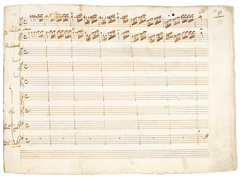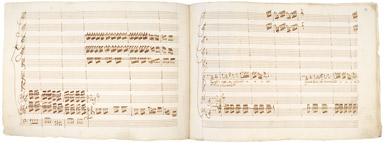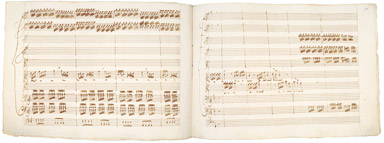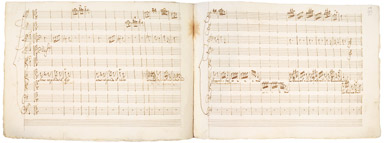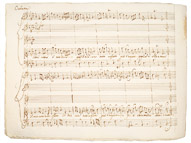If you want to experience the incomparable, the magically different that comes to you over night, take a ship to Venice. At sea, your eyes will take in the vast unstructured void - a sunny morning on earth and on the waves, the tingling, salty, lively waters. Remember how Gustav Aschenbach dreamt of reaching by water a Venice that was different from the town on the lagoon which one approached by land. As if the moist genital of the sea held a belated emotional adventure in store for the travelling idler, the ship turned her bowsprit to Riva degli Schiavoni after cumbersome manoeuvres, and clear and deep young voices mixed with the sloshing sound of dirtily glistening water.
“Who has not battled a fleeting shudder, a secret dread and anxiety upon boarding a Venetian gondola for the first time or after a prolonged absence? That strange conveyance, coming down to us unaltered from the days of the ballads and so distinctively black, black as only coffins can be – it conjures up hush-hush criminal adventures in the rippling night and, even more, death itself: the bier, the obscure obsequies, the final, silent journey. And has anyone observed that the seat in such a boat, that armchair lacquered coffin-black with its dull black upholstery, is the softest, most soothing, most voluptuous seat in the world?” 1
The area located around Riva degli Schiavoni took shape in the Middle Ages. Schiavoni, people from abroad, Dalmatian seafarers gave this Venetian quarter its looks and name. Stonemasons, carpenters and oarmakers set up shop amidst the salt stores, the stone and coal depots. Noisy groups of sailors roamed the streets.
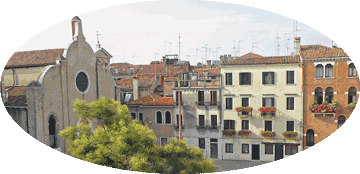
The Campo Bandiera e Moro, the marketplace of the quarter, is located off the lagoon, one block of buildings away. It is almost a square in the geometrical sense, with many passageways, narrow lanes leading to it: Calle del Dose, Calle della Pietà, Calle Terrazzera, Calle della Morte, Salizida del Pigirater, Calle in Crossera. Shopwindows display pieces of glass, red, green or sky-blue. A fluffy magenta-coloured cloud passes across the sky.
Life in a network of micro-spaces has been preserved here, the area between the Arsenale and Riva degli Schiavoni has remained true to itself, close to the people, very much alive. Its picturesque character is owed to many little things: the small shop which opens in the early morning, the osteria with its tables in the shade, the bench underneath the fragrant mulberry tree where locals chat in Venetian dialect, children playing on the Campo, within earshot of their mother at the kitchen window. And Africans who sell bags – at dusk they sit down in a circle to get some rest in the square. Video
The church of St. John the Baptist dominates the square. San Giovanni Battista in Bragora is a three-aisled basilica with a ceiling construction of exposed beams. The Baptism of Christ by Cima da Conegliano radiates the mild light of the early morning. The monochromatic painting, dating back to the early Renaissance, is located above the high altar.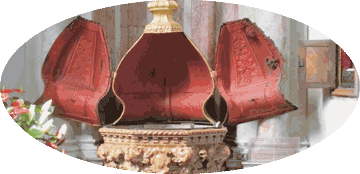
This is the church where you are very close to Antonio Vivaldi, this is where you can see the baptismal font with the red shell shapes where the baby was christened. Don Giovanni Favaretto, the friendly priest, will be happy to show you the entry in the registry, a volume kept in the sacristy. The baptismal font dates back to the fifteenth century, it is an octagonal basin made of red marble from Verona, bearing the crest of the Gritti family. It is located in the side chapel on the left. The material is exquisite, reminiscent of living things in nature: a calyx, a fruit pod, the glistening eyes of certain exotic animals, and most of all the source of our existence: blood. The Vivaldi family lived in the house next to the church. In 1722 Vivaldi moved to a house at the Fondamente del Doge, and in 1730 he relocated to the spacious building in Calle San Antonio on the Canal Grande.
This is what we know about Vivaldi’s baptism: Antonio Lucio Vivaldi was first administered an emergency baptism by the midwife – she was afraid he would not survive. He was born on March 4, 1678. Two months later, the baby was taken to church for his baptism. In the register of baptisms at San Giovanni Battista in Bragora we find the following entry for him: »On May 6, 1678 Antonio Lucio, son of Giovanni Battista, in turn the son of the late Augustin Vivaldi, an instrumentalist, and of Camilla, daughter of the late Camillo Calicchio, his wife, a boy born on March 4 this year, who was baptised by his godmother, the midwife Margarita Veronese, was taken to church today and administered the exorcisms and chrism by myself, Giacomo Pacacieri, parish priest, while he was carried by Antonio, son of the late Gerolemo Vecchio, from the Doge’s Pharmacy in our parish.« Video
The adolescent will set his desires and feelings to music; he is endowed with the talents required to do so. Time passes under the bright sun of the city on the lagoon.
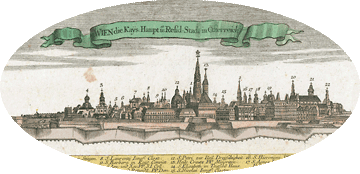
62 years later: the year is 1740. On Wiedner Hauptstrasse, the road linking Vienna with Styria, Carinthia and Italy, tread by armies and pilgrims since it was first mentioned in a document in 1211 and most likely before that, a horse-drawn coach coming from Venice is approaching Vienna, the capital and seat of power.
There are no clouds in the sky, it is wide open, there is a breeze, the huge bales of hay on the cart in front of the coach are swaying, and the hooves of the four horses raise the dust.
Antonio Vivaldi’s coach crosses the suburb of Wieden and passes through the Carinthian Gate, he will take up his lodgings at the “House of the Flying Horse” close to the theatre at the Carinthian Gate. 2
Under the sun of Vienna, he drank from the chalice of death, filled to the brim.
An abundance of sonorous vibrations resonated through the Imperial and Royal capital.
The city is a constant source of excitement for the intruder. It never sleeps, relentlessly driving the stranger to roam its streets day and night, and particularly by night it attracts the voyageur with its enigmatic constellations, coincidences and destinies.
»Is it good, is it bad? We often speak about a city as if it were a person, we ogle its whims, describe its temperament, attribute a character to it. We bend over it as if it were a child, it is after all equally unpredictable. We explore its body, which is as mysterious as the body of a woman. We watch it live, hope to unveil its mystery.
Is it good, is it bad? A mere trifling may suffice to overturn everything within a split second. Shortage of bread, a fire or a flood, a rumour or fear spreading in the streets, a celebration, a scuffle, and a yawning chasm will open on the seemingly calm surface.« (Arlette Farge).
Vienna, built on pebbles, mud and silt just a few yards above the sea level, has a swampy soul, the soul of a sand dune, of a fishing village.
Like the intertwining links of chain in a necklace, the city’s towers reach up to the sky. Hundreds of bricklayers and day labourers slaved in the brickyards day in, day out so they could be built. The system of war mobilised perception just like it mobilised arms and actions. Ruses of war are pervasive.
The city has 110 streets, big and small, on the whole they are neither wide nor straight. The houses are solid and durable, mainly made of bricks, rarely made of stone. In Vienna, they build houses in no time at all.
The epic stock-taking of every-day life as it whirs by lists churches, monasteries and palaces, with a notion of merciless toughness and commanding aspirations hovering over the towering houses. Wherever you look, there are representations of the passion of Christ, saints pointing to the skies, gold-winged angels seeking to reach the divine heavens. The ground is littered with the rags of poverty, and many backstreets are filled with stories of suffering.
On the one hand, there is the city and the state with their boundaries, and on the other hand, there is a totally different line on the horizon: the nomads’ trail. They come and go as they please, crossing borders as they move back and forth, forming swarms and packs. They are organisations existing simultaneously with the established apparatus of the state. Their position is far from normal: they live in the woods and in the fields, they sleep on heaps of straw, next to animals and on plants. They all live under the laws of wilderness, the rules of outlaws. Abnormality is a position or a group of positions different from diversity. The origin of the pack is different from the origin of the family and the state. The pack relentlessly affects the family and the state from bottom-up, disrupting lives by means of other forms of life and expression. They are like the winds and storms, like bacteria infecting people. »On the plane of consistency, a body is defined only by a longitude and a latitude: in other words the sum total of the material elements belonging to it under given relations of movement and rest, speed and slowness (longitude); the sum total of the intensive affects it is capable of at a given power or degree of potential (latitude). Nothing but affects and local lovements, differential speeds. The credit goes to Spinoza for calling attention to these two dimensions of the Body, and for having defined the plane of Nature as pure longitude and latitude. […]
You have the individuality of a day, a season, a life (regardless of its duration) – a climate, a wind, a fog, a swarm, a pack (regardless of its regularity). […] The street enters into the composition with the horse, just as the dying rat enters into the composition with the air, and the beast and the full moon enter into composition with each other. […] Climate, wind, season, hour are not of another nature than the things, animals, or people that populate them, follow them, sleep and awaken with them.« 3
The city is a unique container for objects of all descriptions, blunt and pointed, soft and hard, round and angular, light and dark. The big city combines the most abstruse things and persons in figures and constellations. Pleasure and entertainment create the actual rhythm of life. The influential upper crust of Vienna delights in that special hand cream, in the famous strawberry water which makes the skin so tender. Decorated with minute carved ornaments, engraved, gilded and pearl-studded, the coquettes’ fans, the epitome of rococo airs and graces, was often painted with bright allegories of love – the Italian generosity of Louis XIV’s day and age coming to the fore.
A tick can wait in a tree for months without moving until a warm-blooded animal passes underneath; it then drops, pricks the skin and starts feeding on the animal’s blood. The only thing the tick knows in the world is warm blood. Likewise, the parasitical upper classes of the baroque age saw their subjects as a means to an end, not as human beings. Absolute power resting on theological foundations formed the substrate for the baroque sovereign’s tyrannical transformation, brought to perfection in the sovereign as a tyrant. 4
Imperial Vienna had many perverse cravings. Nobility, made up in Greco-Roman style, loved eating, drinking and fornication day and night.
The dedication of the twelve concerti op. 9, La Cetra (»The Lyre«, print, 1727) to Emperor Charles VI is a first indication that Vivaldi was in contact with the court in Vienna. The print must not be confused with the eponymous autograph manuscript dated 1728, which can be found in the Austrian National Library in Vienna (Music Collection, inventory number HS 15996). The twelve concerti have not survived in their entirety as the solo violin part is missing in some, so that as many as five of them can no longer be performed.
The text of Vivaldi’s dedication in the print of opus 9 meanders, curls, weaves in and out like a vine:
»Your Sacred Imperial Catholic and Royal Majesty,
Surely, Your Sacred Imperial Catholic and Royal Majesty, the deeply rooted and age-old custom of putting the name of a famous and great personality at the top of a published work is praiseworthy for many reasons: it is an expression of the fact that the author holds this personality in veneration and at the same time, of the hope that the worthy name will protect the work from the criticism of others. Thus, most exalted Emperor, I do not believe to commit the sacrilege of boastfulness when I adhere to this praiseworthy custom and offer the audience my work, however welcome it may be, with the glorious name of a monarch who is indeed the most clement, generous and charitable protector and patron of the arts. The arts flourish and thrive in the shade of Your unvanquished rule, and thanks to Your generous protection, they are the beacon of our day and age, belittling the past and becoming the object of envy for the future. Therefore, I am asking Your Sacred Imperial Catholic and Royal Majesty to accept my humble gift with your usual kind benevolence while I pray with the entire Catholic world that You may live long to multiply your glory, to protect the arts and to safeguard happiness.
ANTONIO VIVALDI.« « 5
Given such luxury of rhetorical devices, one should remember that originally there were two expressly functional types of speeches, judicial and political, but antiquity added a third category, epideictic speech, pertaining to ceremony and display, which was to instil admiration in the listeners. Vivaldi frequently dedicated works and his dedications were applied to a wide variety of persons and situations with such constancy that it is safe to assume that they were examples of a discourse in sync with the pathetic character of his time.
Vivaldi failed as an opera composer in Ferrara and was dismissed from his position as a music teacher at the Ospedale della Pietà 6 in Venice – for a composer of renown in Europe, this meant a deep existential crisis, and he was to seek shelter at the court of Emperor Charles VI. in vain. He looked for clients among the nobility of Vienna and Bohemia as well as middle-class theatre owners – he had high hopes that his opera L’oracolo in Messenia would be staged at the Kärntnertor Theatre 7 . However, all his projects were to fail.
On October 20, 1740 Charles VI., the Roman-German Emperor, unexpectedly died of mushroom poisoning, and his death led to a one-year period of mourning during which all entertainment was prohibited. 8 Mars, the god of war, reigned supreme in Europe as Maria Theresa, the daughter of Charles VI., had come into an unstable inheritance.
As from December 16, 1740, the ruler was to fight the Austrian War of Succession. 9
There is no way one could come up with 101 stories about Vivaldi’s life in Vienna. The evidence of where Vivaldi lived and what he did in Vienna consists of a handful of documents from which biographical miniatures can be derived at best - »biographemes«, to quote Roland Barthes.
»Vivaldi’s departure [from Venice] must have taken place shortly after his last salary was paid by the Pietà. According to a court record dated July 4, 1740, the bailiff came to his flat on May 24, 25 and 27 to summon him as a witness. As singers had sued for their fees for the last opera performed in the autumn of 1739, Feraspe, for which the impresario Dini had been responsible, the composer was to be heard about his own fee. However, the neighbours said that he had already ›left the town‹. Thus, he must have departed [for Vienna] between May 12 and 24, 1740.« 10
Vivaldi paid a first visit to Anton Ulrich, Duke of Saxe-Meiningen, one day in a very snowy winter, on February 8, 1741, seeking to sell his concerti. He had already tried twice to see the Duke but although Saxe-Meinigen was known as a patron of music and had always amassed huge collections of scores and the like when visiting Vienna, he did not receive Vivaldi. 11
»Und Schnee, wie Majenblumen
Das Edelmüthige, wo
Es seie, bedeutend […]«
»For snow sparkles on an alpine meadow,
half-covered with green, signifying generosity,
of spirit in all situations, like flowers in May […]«
Friedrich Hölderlin · Mnemosyne
A baffled, downtrodden man with a little bit of tenacity left in him, Vivaldi walks around Vienna, on streets that are like the frozen surface of a lake.
A drab day ends, a humdrum morning breaks, a month passes, another one starts.
It is easy to be lost in a city that is as big as the world. High grey houses everywhere, the greyness of the day, the death rattles from the slaughterhouses, the thudding of machinery in the manufactories, almost all creatures are ill-treated, wastelands of melancholia, evenings full of death.
Imbued with the life and death which are all around, all the unconsoled people are unspeakably sad – as if this were a matter of course, as if this were the mechanics of destiny.
Another document reflects the sale of twelve musical scores for a small amount of money. On June 28, 1741 Antonio Vivaldi acknowledged, in his own hand, to the secretary of Tommaso Vinciguerra di Collalto (1710-1769), a nobleman from Friuli, that he received twelve Hungarian ducats »per tanta musica«:
»June 28, 1741 Vienna / I, the undersigned, hereby acknowledge to the secretary of His Excellency, Antonio Vinciguerra, Count of Collalto, that I have received 12 Hungarian ducats for the account and upon the order of His Excellency for music sold to him. Value 12 ungari. / I, Antonio Vivaldi, in my own hand confirm this to be true and correct.« 12
It seems like Vivaldi is blindfolded when issuing the receipt. He knows that the quill will baulk in view of the ridiculously small fee. Without knowing whether he has indeed committed letters and numbers to paper, he signs in a handwriting that is reminiscent of plant shapes. According to Wittgenstein, the letters of his name reflect the sadness of the previous months, the name looks like an adjective.
Vivaldi’s dying day, or rather the night of July 27/28, is only 30 summer days away from the date of the receipt, June 28.
He is wasting away, with no way out and soon to run short of money.
In Vienna, he is a stranger, an alien. A jobless musician.
A disreputable person.
A supplicant.
In Vienna he is a lodger amid the war caravan.
Greek - xeniteia: residence abroad.
Greek - xenos: alien, stranger, foreigner, mercenary.
Greek - stenochoria: bottleneck, shortage, need, distress.
»Cold and improbable in its own pure being,
A scorching pure whiteness in the glacial flood:
A dream wrapped in scorn, and a phantom, seeing
How futile is exile for the Swan.« 13
It is heart-rending to see a famous composer fight for his survival, struggling to make his weak body continue to function, so the blood in his veins will not stop flowing and reaching his saddened heart, so he will not stop breathing although he knows that every breath takes him one step closer to his end, although he can smell the unavoidable reek of death: despair, weakness, weariness, enfeeblement, a man whose body and mind have been exposed to such terrible conditions is working to keep all the parts of his eroded self together, under attack by inexorable fate. The body has arrived at the limits of tolerance and strength.
Vivaldi’s art is an accomplice to asthma. Lung conditions cause fever and fatigue, so Vivaldi’s life vacillates between the acceleration and deceleration of breath.
In the end, Vivaldi’s lung breaks like a piece of china. Just like hot zones, cold and warm currents can be traced in submarine and volcano maps, the disease has left an irremovable clot in the lung, he dies of »pulmonary gangrene«. 14
Descriptions of death are accounts of episodes on the way to passing, across various stages of dying – and dying can be a long process.
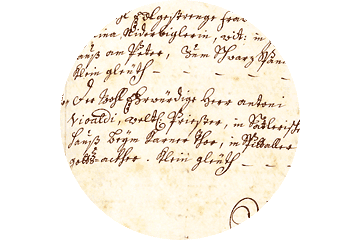
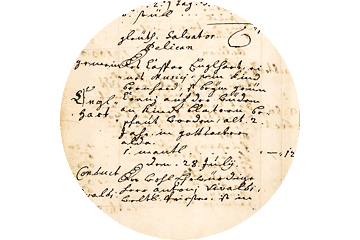
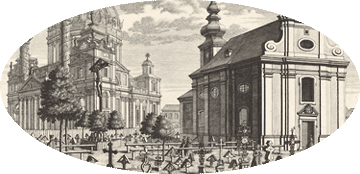
Antonio Vivaldi died in Vienna during the night of July 27/28, 1741. On July 28 he was buried in the Bürgerspital graveyard, located in what was then the suburb of Wieden. He was 63 years old. The undertaker had been the last person to keep him company.
Death in the summer. If you have ever lost someone dear, you will with terror remember the season, the light, the flowers, the fragrant air, the harmony or stark contrast between mourning and sunny skies. How can you be hurting when the sun is shining!
The last documents that provide us with evidence about Vivaldi’s stay in Vienna are the coroner’s records and the register of burial charges at St. Stephen’s Cathedral. The entry in the register of burial charges reads as follows: »Conduct / Der wohl Ehrwürdige / Herr Antoni Vivaldi, / welt[licher] Priester, ist in / Satleri[schen] Haus beym Kar- / ner Thor an In[n]er[lichen] Brand / bschaut worden, alt 60 / Jahr, in Spitaller Gotts / acker. / Kleingleüth ... 2,36 / Herrn Curaten ... 3,- / Bahrtuch ... 2,15 / Pfarrbild ... -,30 / Grabstell ... 2,- / Bahrleicher und Mesner ... 1,15 / Kirchendiener ... -,30 / 6 Trager mit mantl ... 4,30 / 6 Windlichter ... 2,- / 6 Kuttenbuben ... -,54 / Bahr ... -,15 / Pelican / S[umma] 19,45 [19 Gulden und 45 Kreuzer]« [Funeral procession / The Hon. Mr. Antonius Vivaldi, secular priest, who died of pulmonary gangrene at the age of 60, was seen by the coroner at the Waller House next to the Carinthian Gate was buried in the graveyard of the civic hospital. Ringing bells … 2.36 / Curate … 3.00 / Shroud … 2.15 / Parish picture … 0.30 / Rack … 2.00 / Bier rental and sexton … 1.15 / Sacristan … 0.30 / 6 bier bearers in coats … 4.30 / 6 lanterns … 2.00 / 6 altarboys … 0.54 / Bier … 0.15 / Pelican / Sum total 19.45« [19 florins and 45 kreuzer = approx. € 600) 15 Video
A copper engraving by Salomon Kleiner shows the area of the Bürgerspital cemetery with tipping crosses, shapeless mounds, a high cross and a wooden fence. 16 The sacred area, the locus sacer is separated from the rest of the grounds, usually by rosebushes. A map of the suburb of Wieden contains the name »Rosengassen« (“Rose Lane”).
Let us take a look back in history: When the plague was rampant in Vienna in 1571, Mayor Hanns von Tau bought a vineyard in the suburb to bury the dead. 17
After the end of the epidemic, the parish of St. Stephen’s continued using the cemetery for seventy years. In 1640 the parish ceded it to the Bürgerspital (“civic hospital”). The name »Armensünder-Gottsacker« (“graveyard of poor sinners”) dates back to the seventeenth century. As from 1638 Friends of the Poor Souls, a group which belonged to the discalced Augustinians, buried those sentenced to death and executed in the Wieden graveyard. The names of executed criminals can still be found in a register, the »Verzeichnus deren von einer Hochlöblichen Privilegirten Kay(serlich) König(lichen) Todten Bruderschafft übernohmenen Malleficanten«. 18 The cemetery was destroyed during the Second Turkish Siege of Vienna in 1683. After the reconstruction of the church and several stages of extension the parish priest Joseph Lachenbauer closed the graveyard, based on the Imperial edict of June 30, 1783. The chapel was torn down and the grounds were auctioned off as building land. In 1815 the Polytechnical Institute was built on parts of the former cemetery.
The cemetery is a place where the lower middle classes and the proletariat are buried. The »Spitaller Gottsacker« is an area of one acre and 213 square fathoms [= 0.652 hectares] situated south of the Wien river. The Wien is a torrent roaring through its bed like a phallus out of the mountains, a big river with water reminiscent of sperm. Pitch-black feet are wading in the foaming waters and the laughter of children in rags echoes across the sandbank.
Vivaldi’s musical production is masterly and determined from the very start. It moves about in all directions of musical expression, with musical notation that again and again pauses to bring out the tenderness of the moment.
The restless art embodied in his work is due to the compulsive motor force of his hand.
Artistic practice is always linked with the body, with its erotic dimension – music, graphics or writing created by the hand.
It is about the hand moving back and forth, requiring paper, inks. When the quill touches the paper, the only things that make a difference are the pressure, speed, angle and direction of writing. When notes are committed to paper, the quill is controlled by the thumb and the fingers, the movement of the writing hand depends on the thick or thin consistency of the ink and how wet the tip of the quill is, what the paper surface is like. Thus, two different factors combine to determine the movement as quick and fluent handwriting or the exact opposite.
The pigment which the artist brings to the music paper, the brown ink, is varied, with all the magic that colours can do. Colour is usually an expression of drive, colours seek to show excitement.
The act of writing music creates a regular web of passion, with the tumultuous activities of the body being subdued or resurfacing. Vivaldi’s music is written in this pulsating style, even the most minute intervals reflect the great gesture of a feverish man. Here and there, we see that the flow is more or less interrupted, certain kinks appear in the bustle of notes. Drafts and sketches leading to the final score are twined and looped.
The stormy sea, the lights and shadows, cold and heat of Venice certainly intensified Vivaldi’s fickle disposition - »a man with too much mercury in his constitution«, as William Hayes described him. The way in which Vivaldi uses dynamics in his music is remarkable, just like his approach to keys; some say that Vivaldi occasionally anticipated ideas of the Viennese Classics, especially Schubert. Musicologists eventually identified thirteen dynamic stages in Vivaldi’s music – music as the elaborately calculated mathesis of many moods and modes.
The art of music is a precious vessel catching unrest and excitement. The artist’s position is that of a distinguished craftsman, his only job being to give the most burning and chaotic of all human passions the most crystalline of all shapes. These are the musical and poetic explosives hidden in Vivaldi’s operas.
The awe that can be triggered by Vivaldi’s music soars, moves, takes vocal shape outside the normal vocal range. The singer’s voice is diffused, penetrates the entire body surface, through the skin. The singer’s voice is like cream. It is not impalpable breath but physical, material – sound metal struck and hardened in the throat.
Vivaldi’s vocal music – a corpus yet to be fully discovered – is a tightrope walk, a constant state of emergency, a string of musical affects, a frenzy of music of the sort which Bellini was to bring to formal perfection later. It is made to measure for the singers by virtue of the composer’s masterly skills, containing everything that the singing voice is capable of. Vivaldi allows the voice to soar to unthought-of heights, echoed by the flute: Questa dolce cosa! Music with the tender grace of the rococo age, descending chromatic sequences doing away with static sounds, the tones create a vortex, a furious whirl. We are reminded of the baroque cupolas where the figures are painted in a state of suspension between reality and fiction. In this sacred theatre, saints and heroes fall from dizzy heights or rise to endless skies, all seemingly unfettered by gravity, in a state of balance between here and there, the mortal world and the hereafter.
The religious feeling so beautifully expressed in Vivaldi’s liturgical music is not so much about religious dogmas, it has more in common with pietism, with a lyrical, highly emotional approach to religion – Klopstock’s Messias – with the sentimentality of the eighteenth century when spirituality and human feelings sought to come into their own. The artist also had obvious religious ties which came to bear on his creative work: Vivaldi was a Dominican friar.
It is evident that Vivaldi’s music is akin to painterly effects – it is not too far removed from Watteau or Fragonard, and sometimes even closer to Giorgione and Tiepolo: his is the music of colours. Ultramarine, apple green, mauve, pink, sulphur yellow and azure blue are the colours in Vivaldi’s music. Sometimes, it describes the »tristezza atroce della carne immonda« which d’Annunzio speaks of, too.
It is surely possible that Vivaldi was a vain composer exhausted by long and careful procedures of dressing, someone who liked the impeccable claret tailcoat and elegant shoes, a man who spoke with the soft accent of Venice. Staunchly frivolous, Vivaldi succeeded in composing music with a kind of cherry red tone, something which requires a long time to come to fruition, the alchemy of slow maturing. The androgynity and lasciviousness of the baroque age is reflected in the oscillating musical figures Vivaldi was able to give. This kind of music must be read with the paintings coeval with it: Tiepolo’s ginger-haired page with the pink collar and gilded tasselled cushion – one of the most delightful ephebes in painting – reflects the acme of Venetian art.
Antonio Lucio Vivaldi died when his work was done. He died in a summerly room.
In the night, heading for the night, dead of night.
A body in death throes.
They carried the foreigner’s body to St. Stephen’s Cathedral on a bier, and it is said of some that they departed in the summer. The blue of the sea and the tan colour of the sand in the town on the lagoon are far away. »Put your hand on my forehead for a little while to give me courage«, he may have said to his companion and lover as he lay on his deathbed. The musician Antonio Vivaldi and the singer Anna Girò were something like a duality. 19 They attracted each other, they pulled each other, sometimes she led and he would follow, or vice versa. Allowing it to happen, the greatest happiness of all! Anna’s red lips seal the end of his life with a kiss. She lovingly strokes his forehead, straightens his clothes. A man of slight build is lying on the bier. The death-knell, flowers in the green ambiance of midsummer – when the gravedigger begins to dig the grave, the stench of putrefaction rises from the soil. Horses raise their heads from the well, in the distance, a cross stands out amidst the woodbine.
Und da sind die Raben:
»Manchmal kann man sie keifen hören
Um ein Aas, das sie irgendwo wittern
Und plötzlich richten nach Nord sie den Flug
Und schwinden wie ein Leichenzug
In Lüften, die von Wollust zittern.«
And here are the ravens:
»[…] and at times you can hear them bicker
about a corpse they sniffed-out somewhere,
and sharply they bend their flight towards north
and dwindle away like a funeral
march in the air, shivering with bliss. «
Georg Trakl · The Ravens
[Translated by Eric Plattner & Joseph Suglia]
In Vivaldi’s music there is always something to tell you where you stand in time, which season of the year it is, what the sky above you is like, the cold and the light – just a few bars and you are right in the centre of the cosmos in its most direct form. You always sense the season, as an aura and a symbol.
The weather, the seasons: the essence of life, of memory, as it were. To claim the seasons (the weather) means to continue the interest of agricultural civilisations in the seasons and the weather. Several works by Antonio Vivaldi are witnesses, memorials to the seasons.
In Vivaldi’s works music is born anew, with rural freshness.
The mild and warm caress of the sun, the feeling of easiness, of mirth outdoors and inside. A soft light, the clear blue colour of the air. Vivaldi’s Zephyros Aria makes us feel the warmth. 20
